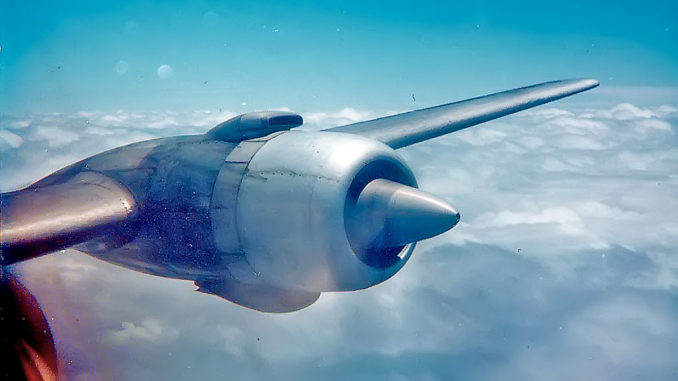
Albita’s ferocious Latin rhythm was just reaching its peak as the film spun through my camera …
I guess officially I was on a photo assignment, but in reality I was just helping out some friends of mine at South Beach Magazine. They had asked me to shoot Albita’s new CD premiere show at Yuca’s upstairs nightclub on Lincoln Road for an upcoming interview they were planning, and I was happy to do it for them. Albita Rodriguez, in case you haven’t heard, is the Cuban entertainer who, while touring in Mexico, stepped across the border at El Paso into the land of the free, bid adios to her former life, and is now becoming the hottest pure Latin performer here since Xavier Cugat hit Miami Beach in the 1940’s.
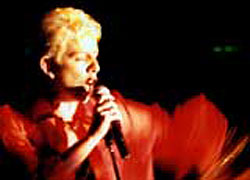
Photographing a concert is quite a departure from my true profession. Normally, I fly a DC-10 for Continental Airlines on the New York to Amsterdam route, but I’d been planning on catching Albita’s show for some time, so there I was at Yuca, Canon in hand, squeezing off 15 rolls of film three frames at a time, hoping for that one perfect shot.
For reasons I’ve never been able to figure, some nights turn out to be magical in their makeup, and this one was shaping up just that way. Maybe it was Albita’s music that set the mood, or maybe it was the stage lights reflecting off of the jubilant faces in the crowd, but whatever the reason, as I photographed Albita’s performance, thoughts kept popping up in my mind and I had no idea why. (…Havana, Castro, DC-6’s, Tropicana…) As the rhythm swirled through the nightclub and the film wound steadily through my camera, the thoughts kept coming back to me, over and over. (…Pilots, Bay of Pigs, Cubana Airlines…) Vignettes from the past. Fleeting thoughts. Where were they coming from?
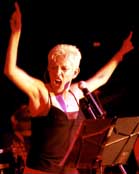 Then, just as I raised my camera to shoot the next 36 frames of film, it hit me. It all came back to me why this night with Albita seemed so familiar. I remembered in an instant why the music, the people, and the whole mood was something I was so familiar with. The answer was in the stories told to me by the old Cuban pilot I had flown with years ago. Stories of Havana in the ’50’s.
Then, just as I raised my camera to shoot the next 36 frames of film, it hit me. It all came back to me why this night with Albita seemed so familiar. I remembered in an instant why the music, the people, and the whole mood was something I was so familiar with. The answer was in the stories told to me by the old Cuban pilot I had flown with years ago. Stories of Havana in the ’50’s.
Getting an airline pilot job in the late ’70’s was no minor undertaking. Competition was fierce for the few positions available and there were hundreds of well qualified applicants around with thousands of hours of flight time in large transport aircraft. And then, there was me……with almost enough flight time, in airplanes that were almost big enough to qualify me for an airline pilot job. I knew that if I was going to break into the big leagues and land that dream job with the major airlines, I needed to get some flight experience in large aircraft. I needed this flight experience in the worst way, and that’s exactly how I got it.
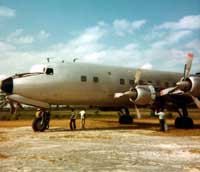
Miami airport’s infamous “corrosion corner” was a notorious haven for bandit operators flying 50 year old junk airplanes to obscure points in South America. “You Call, We Haul” type operators who took advantage of loopholes in the sixty year old Federal Air Regulations which allowed them to fly just about any piece of junk that would get airborne. Most of the airplanes in corrosion corner were already worn out before I was born, but they were big and loud, and they were just what my logbook needed. So, one day I got my nerve up and walked in to the least cheesy looking hanger I could find and began telling the boss what a great asset I would be to his organization. Halfway through my speech, without even looking up at me, the guy blurted out, “We pay four cents a mile; be here at midnight, and try to be sober.”
Hmm…no FAA approved training program…no route qualification linecheck…not even a cursory check of my pilot license to make sure I even had one. But I could tell this was going to be a real people oriented organization to work for…after all, the guy had told me to “try to be sober.”
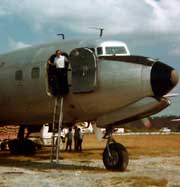 So, at 11:30 that night I found myself in total darkness on an oil-soaked ramp in the middle of corrosion corner pre-flighting a 36 year old DC-6B that looked like what James Stewart had left behind in the desert in the movie “Flight of the Phoenix.” The flight plan was Miami to Paramaribo in Dutch Suriname, by way of Andros Island in the Bahamas and Port-Au-Prince, Haiti. Nine hours and twenty-eight minutes over a dark, lonesome ocean in an airplane that was built before “I Love Lucy” was a hit.
So, at 11:30 that night I found myself in total darkness on an oil-soaked ramp in the middle of corrosion corner pre-flighting a 36 year old DC-6B that looked like what James Stewart had left behind in the desert in the movie “Flight of the Phoenix.” The flight plan was Miami to Paramaribo in Dutch Suriname, by way of Andros Island in the Bahamas and Port-Au-Prince, Haiti. Nine hours and twenty-eight minutes over a dark, lonesome ocean in an airplane that was built before “I Love Lucy” was a hit.
The first officer soon showed up and as we got to know each other, I asked him, “Who’s the captain tonight?” He replied, “Luis Cosme, you’ll like him, he’s a great guy.”
The first officer was right.
If looking the part counted for anything, Captain Luis Cosme had it covered. A distinguished looking Cuban gentleman sporting a dark pompadour with just a touch of gray at the temples, and the ever-present half-smoked cigarillo in his left hand. Sean Connery with a little Gilbert Roland thrown in, I’d say.
When Captain Cosme arrived, our pre-flight preparations were almost complete and the first officer and I were sitting in the cockpit waiting to go. All that was left was the captain’s takeoff briefing and we’d be ready to start engines.
Takeoff briefings began as a custom among airline crews decades ago and have long since become standard operating procedure with all airlines around the world. During the briefing, which is usually accomplished just before engine start, the captain discusses items such as enroute weather conditions, the route to be flown, known mechanical problems with the aircraft, and the planned course of action in case of engine failure.
Now, I’ve heard thousands of different takeoff briefings in my career and they’ve ranged from detailed 20 minute dissertations, to a simple “…f#ck it, let’s get going…”, but the briefing I heard on this night will stick with me forever. After covering the usual items in the briefing, Captain Cosme added the most somber statement I’ve ever heard. In his Cuban accent he said, “Gentlemen, I warn you now. If we have an engine problem out over the ocean tonight that renders us unable to stay airborne, we will attempt to make Montego Bay or maybe Grand Cayman, but, I promise you, we will ditch this aircraft in the ocean and take our chances with the sharks before we land in Cuba.”
You see, Captain Luis Cosme had been the Chief of Air Operations in the Bay of Pigs invasion.
In 1961 Luis had strapped on a Douglas B-26 and joined 1,200 of his countrymen in a valiant attempt to retake his homeland from Fidel.
(NOTE: Whatever importance history may or may not assign to the Bay of Pigs Invasion, it did prove one thing absolutely; that there are still brave men in the world who are willing to give their lives for freedom. For whatever it may be worth, I salute these heroes, one and all.)
And Luis knew that if he ever returned to Cuba, even if he was lucky enough to escape the executioner, he would spend the rest of his life in a six by six suite at the Chez Castro. Hence, the ominous takeoff briefing.
In the months that followed that night, I flew many flights with Luis, and he soon began to talk about his life in Cuba, “B.C.” (Before Castro). As our ancient DC-6 groaned away over the ocean night after night, Luis’ face would always brighten when he spoke of Cuba.
Before Castro, Luis had been an officer in the Cuban Air Force and, as was the custom in Cuba, he was often assigned to operate flights as a crewmember for Cubana, the national airline of Cuba. He spoke proudly of the special training he had received to qualify him to operate in and out of Idlewild Airport in New York, and of the “Dinner Flights,” where Cubana would fly passengers from Miami to Havana for dinner and dancing in the Havana nightclubs, and then fly them back to Miami the next morning. He spoke glowingly of the Lockheed Constellation that had “…the tuxedo-wearing hombre, playing piano in the first class section.”
He also spoke of how happy the Cubana pilots were when they took delivery of the new Bristol Britannia, a prop-jet airliner that finally allowed Cubana to outrun Iberia Airlines on the Havana to Madrid route. With each story he told, I saw a man with great pride in his country. A country that had been taken away from him.
Some of his most colorful stories were of Havana’s nightlife. After dark, Luis said, the pulsating “criollo” spirit would envelop the entire city. Nights often began with cocktails at the Floridita Bar where an earthy American writer named Hemingway was often seen observing the human comedy such places always produce. Travelers from all over the world would come to celebrate life and drink the bar’s most famous creation, the Frozen Daiquiri.
Luis’ favorite nightspot was the Tropicana, which was located mostly outdoors in a lush tropical setting. The Tropicana would produce dazzling light shows featuring Cuba’s most beautiful women wearing little other than the extravagant head-dresses the nightclub was famous for. He remembered minute details of the performers, the songs, and the Hollywood celebrities that were frequent guests of the Tropicana’s owners. He remembered who sat where, and who said what.
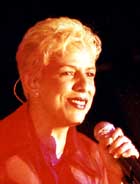
Hour after hour I’d lean forward in the flight engineer’s seat and listen to the captain’s wonderful stories of Havana nightlife. Luis would paint vivid pictures of the music and the dancers. Pictures of the shows and the performers. Pictures just like I was seeing through the viewfinder of my camera on this night with Albita.
(…nine…eight…seven…six…) As the film counter in my camera slowly wound down, I became a little more miserly with the shutter release button, not wanting to let that one in a million shot pass by with no film left in the camera. You see, some pictures are only there for the briefest period and then they’re gone forever…
…like the Captain’s Havana, of years gone by.
Epilogue:
Captain Luis Cosme passed away on July 20th, 1999 at his home in Miami.
I wish you blue skies forever, my friend. Adios…
